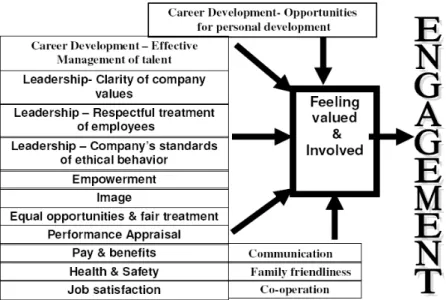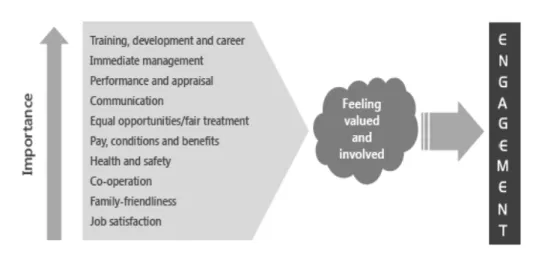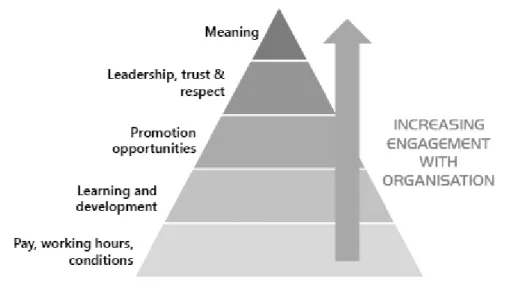Dharmendra MEHTA 1 Naveen K. MEHTA 2
ABSTRACT
Motivated and engaged employees tend to contribute more in terms of organizational productivity and support in maintaining a higher commitment level leading to the higher customer satisfaction. Employees Engagement permeates across the employee-customer boundary, where revenue, corporate goodwill, brand image are also at stake. This paper makes an attempt to study the different dimensions of employee engagement with the help of review of literature. This can be used to provide an overview and references on some of the conceptual and practical work undertaken in the area of the employee engagement practices.
KEYWORDS: Employees, leadership, engagement, performance, satisfaction, relationships.
JEL CLASSIFICATION: M10, M12, M19 & M51
INTRODUCTION
The concept of employee engagement is a measurement of how happy employees are with their respective jobs, working environment and how efficient their performance levels are? Managing high morale among employees can be of remarkable benefit to any organization, as actively engaged workers are more productive and stay loyal to the company. Organizations with high employee engagement levels are more productive and more profitable than those organizations with low levels of employee engagement.
1. OBJECTIVES & RESEARCH METHODOLOGY
The present paper aims to understand the basic concept of employee engagement and to study the different dimensions of employee engagement with the help of review of literature. This paper is based upon review of literature and secondary data collected from various websites, journals, magazines, newspapers and reference books. Literature review has shown prior research work done in this area.
2. LIMITATIONS
There are limitations to this review of the literature. Research was also limited to peer-reviewed business, organizational psychology, and management journals, online journals to identify the state of the employee engagement practices at work and to study the different dimensions of employee engagement with the help of review of literature.
1
3. LITERATURE REVIEW
Kular et al. (2008) explored Five key areas: What does ‘employee engagement’ mean?; How can engagement be managed?; What are the consequences of engagement for organisations?; How does engagement relate to other individual characteristics?; How is engagement related to employee voice and representation? Robertson-Smith and Markwick (2009) throw light on what engagement is and reveals that it is an important yet complex challenge, and there remains a great deal of scope for discussing the various approaches. Simpson (2009) discussed that the current state of knowledge about engagement at work through a review of the literature. This review highlighted the four lines of engagement research and focuses on the determinants and consequences of engagement at work. Susi & Jawaharrani (2011) examined some of the literature on Employee engagement, explore work-place culture & work-life balance policies & practices followed in industries in order to promote employee engagement in their organizations to increase their employees’ productivity and retain them. Work-life balance is key driver of employees’ satisfaction.
Ram & Gantasala (2011) investigated the antecedents and consequences of employee engagement in Jordanian Industry. Bhatla (2011) focused on the need for such employees and how their presence can improve the progress and work efficiency of the organization as a whole .Also focused on the challenges faced by the HR managers to improve employee engagement for an organization’s survival.
Shashi (2011) reinforced the importance of employee communication on the success of a business. She revealed that an organization should realize the importance of employees, more than any other variable, as the most powerful contributor to an organization’s competitive position. Bijaya KumarSundaray (2011) focused on various factors which lead to employee engagement and what should company do to make the employees engaged. Proper attention on engagement strategies will increase the organizational effectiveness in terms of higher productivity, profits, quality, customer satisfaction, employee retention and increased adaptability.
Siddhanta & Roy (2012) explored implications for theory, further research and practices by synthesizing modern 'Employee Engagement' activities being practiced by the corporate with the review of findings from previous researches / surveys. Singh & Shukla (2012) tried to find out what variables are significant to create an engaged workforce. The study was exploratory in nature and the data has been collected from a tin manufacturing organization.
4. DIMENSIONS OF EMPLOYEE ENGAGEMENT
In 2006, The Conference Board published an article ‘Employee Engagement – A review of current research and its implication’ on the basis of some major studies conducted by Gallup, Towers Perrin, Blessing White, The Corporate Leadership Council and others. It identified following key drivers related to employee engagement as:
Trust & integrity – managers should communicate well and go by their words.
Nature of the job – employees should find their job challenging enough to motivate themselves.
Career growth opportunities – employees should have clear career path and growth.
Pride about the company – employees should feel esteemed by being associated with the organization.
Coworkers / team members – relationship with colleagues significantly increase employee engagement level.
Figure 1. Dimensions of Employee Engagement Source: Kumar (2012)
There are few more drivers’ enables to enhance employee engagement like as:
A culture of respect where good job is appreciated.
Feedback, counseling and mentoring.
Fair reward, recognition and incentive scheme.
Effective leadership.
Clear job expectations.
Adequate tools to perform work responsibilities.
Motivation.
5. RELATIONSHIP BETWEEN EMPLOYEE ENGAGEMENT LEVELS
AND INVOLVEMENT
decisions affecting the job or work to be an important factor, which was strongly associated with high levels of employee engagement thus demonstrating it is an important driver
Lucas et al. (2006) viewed that Employee voice can be defined as the ability for employees to have an input into decisions that are made in organizations. Robinson et al. (2004) highlighted the importance of, feeling valued and involved as a key driver of engagement. Within this umbrella of feeling valued and involved there are a number of elements that have a varying influence on the extent to which the employee will feel valued and involved and hence engaged. Robinson et al. (2004) stated that this can be a useful pointer to organizations towards those aspects of working life that re-quire serious attention if engagement levels are to be maintained or improved.
Figure 2. Robinson’s (2004) Model Source: www.b2binternational.com
Penna (2007) presents a hierarchical model of engagement. This model indicates that staff is seeking to find "meaning" at work. Penna defines "meaning" as fulfillment from the job. Fulfillment comes from the employee being valued and appreciated, having a sense of belonging to the organization, and feeling as though they are making a contribution, and is matching with the underlying theoretical framework of Robinson. Penna states that the organization becomes more attractive to new potential employees and becomes more engaging to its existing staff.
Figure 3. Penna’s (2007) Hierarchical Model Source: Bhatla (2011)
6. MANAGING JOB ORIENTED INDIVIDUAL PERCEPTUAL
DISSIMILARITIES
Cooper (1997) explained that if emotions are properly managed rather than shut out at work, they can drive trust, loyalty and commitment and great productivity gains by individuals, teams and organizations. Buchanan and Huczynski (2004) defined perception as the dynamic psychological process responsible for attending to, organizing and interpreting sensory data. According to Robinson (2006) individuals categorize and make sense of events and situations according to their own unique and personal frame of reference, which reflects their personality, past experiences, knowledge, expectations and current needs, priorities and interests. May et al. (2004) argued that employee engagement is related to emotional experiences and wellbeing. Wilson (2004)remarked that feelings connect us with our realities and provide internal feedback on how we are doing, what we want and what we might do next … Being in organizations involves us in worry, envy, hurt, sadness, boredom, excitement and other emotions.
7. CONCLUDING REMARKS
Employee engagement is linked with the emotional, cognitive and physical aspects of work and how these factors integrated. The concept of employee engagement should not be regarded just another HR strategy. Employee’s engagement is a long term process and linked to core tenants of the business like as, values, culture and managerial philosophy. Employees require to be adopting in a working environment which will lead them to display behaviour that organizations are looking for. An organization has to promote the factors which have a positive effect of engagement through every business activity that they do.
A close study of review of literature reveals that organizations need to communicate the importance of individual contribution to successful business outcomes. It is also suggested that organizations must understand that CSR is s vital element to their employees. They need to consider the views of employees over how best to engage in CSR and well-being activities. Organizations therefore have to develop such cultures where employees are not scared to offer upwards feedback and have candid communication at all the levels. Employers need to understand their employee’s expectations and future plans. This has important implications for job designers to ensure that the meaning and purpose of the role are clearly defined.
After reviewing research, it can also be concluded that high levels of employee engagement may lead to improved employee commitment & involvement towards respective jobs and thus creating a motivated workforce – that will work together to achieve the common goals of the organization.
8. FUTURE SCOPE FOR STUDY
Further research is required to provide organizations with better understanding of the employees’ antecedents and consequences of work engagement. Further exploration of employees’ work environment, particularly the impact of team leader’s behaviors, is important to study. Exploratory studies in this arena may be fruitful for the policy makers and decision takers to harness optimum benefits from employees’ hidden talents.
REFERENCES
Bhatla, N. (2011). To study the Employee Engagement practices and its effect on employee Performance with special reference to ICICI and HDFC Bank in Lucknow. IJSER, 2(8).
Beardwell, J. and Claydon, T. (2007). Human Resource Management, A Contemporary Approach. 5th ed. Harlow, Prentice Hall.
Buchanan, D. & Huczynski, A. (2004). Organizational Behaviour. An introductory text, 5th ed. Harlow, FT/Prentice Hall.
Crabtree, S. (2005). Engagement keeps the doctor away; A happy employee is a healthy employee, according to a GMJ survey. Gallup Management Journal, 13th January. Available at: www. gmj.gallup.com Accessed on 19 December, 2012.
Deci, E.L. & Ryan, R.M. (1987). The support of autonomy and the control of behaviour. Journal of Personality and Social Psychology, 53, 1024-1037.
Development Dimensions International, Inc., available www.ddiworld.com (accessed on October 30, 2011)
Robertson-Smith, G. Markwick, C. (2009). Employee Engagement A review of current thinking, Institute for Employment Studies, University of Sussex Campus Brighton,UK
Kahn, W. A. (1990). Psychological conditions of personal engagement and disengagement at work. Academy of Management Journal, 33 (4), 692-724.
Kular, S., Gatenby, M., Rees, C., Soane, E. & Truss,K. (2008). Employee Engagement: A Literature Review. Kingston Business School, Kingston University Working Paper Series No 19, October 2008.
Kumar, J.A. (2012). Employee Engagement, Saaransh , RKG Journal of Management, 3(2). Lockwood, N. R. (2007). Leveraging Employee Engagements for Competitive Advantage:
HRs Strategic Role. HR Magazine, 52(3), 1-11.
Lucas, R., Lupton, B. and Mathieson, H. (2006) Human Resource Management in an International Context. London, CIPD.
Macey, W.H. & Schneider, B. (2008). The Meaning of Employee Engagement. Industrial and Organizational Psychology, 1, 3-30.
Maslach, C., Schaufelli, W.B. and Leiter, M.P. (2001). ‘Job burnout’, Annual Review of Psychology, Vol 52, pp 397-422.
May, D.R. Gilson, R.L. and Harter, L.M. (2004) ‘The psychological conditions of meaningfulness, safety and availability and the engagement of the human spirit at work’, Journal of Occupational and Organisational Psychology, Vol 77, pp11-37. Moore, K. (2004) ‘The healthy balance among work, family, and personal relationships:
Fact or fiction?’ Proceedings of the APS Psychology of Relationships Interest Group
4th Annual Conference, pp79-84.
Penna (2007). Meaning at Work Research Report,
http://www.penna.com/contentfiles/penna/content/research/e7031f6c-e95e-49ba-9ecc-fad74a0829ec/meaning_at_work.pdf, Accessed on 20 December, 2012
Perrin, T. (2003). Working Today: Understanding What Drives Employee Engagement, in www.towersperrin.com. Accessed on 21 December, 2012.
Purcell, J., Kinnie, N., Hutchinson, S., Rayton, B. & Swart, J. (2003). Understanding the People and Performance Link: Unlocking the Black Box. London, CIPD.
Purcell, J. (2006). Change Agenda, Reflections on Employee Engagement. London, CIPD. Padmakumar, R. & Prabhakar Gantasala, V. (2011). The role of employee engagement in
work-related outcomes. Interdisciplinary Journal of Research in Business, 1(3), 47-61. Robinson, I. (2006). Human Resource Management in Organisations. London, CIPD. Robinson D, Perryman, S. & Hayday, S. (2004). The Drivers of Employee Engagement, Institute
for Employment Studies, Brighton, Report 408, retrieved on December 14th, 2011. Schaufeli, W.B. & Bakker, A.B. (2004). Job demands, job resources, and their relationship
with burnout and engagement: a multi-sample study. Journal of Organisational Behaviour, 25, 293-315.
Siddhanta A. & Roy, D. (2012). Employee engagement engaging the 21st century workforce. Asian Journal of management Research , 170-189.
Simpson, M. R. (2009). Engagement at work: A review of the literature International. Journal of Nursing Studies 46.
Susi, S. & Jawaharrani, K. (2011). Work-Life Balance: The key driver of employee engagement. Asian Journal of management Research, 2(1).
Shashi, T. (2011). Employee Engagement - The Key to Organizational Success. ICOQM-10 June 28-30.
Truss, C., Soane, E., Edwards, C., Wisdom, K., Croll, A. and Burnett, J. (2006) Working Life: Employee Attitudes and Engagement 2006. London, CIPD.
Tulasi Das, V. & Vijayalakshmi, Ch. (2012). Employee Engagement Strategies For Enhancing Employee Competitiveness To Organizational Success. Indian Journal of Applied Research, 1(12)
Wellins, R. & Concelman, J. (2011). Thought Leadership, www.ddiworld.com/pdf/ wps_engagement_ar.pdf accessed on Dec8th,2011


